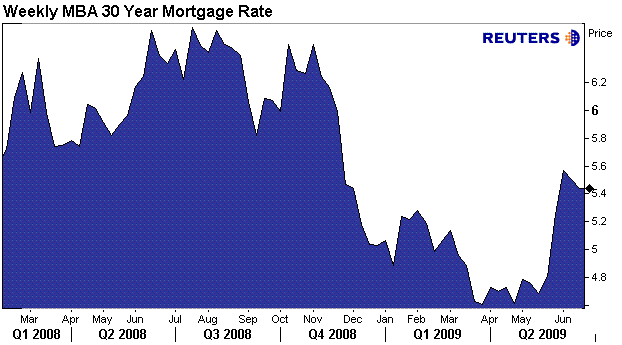Following Monday’s fairly calm day, mortgage backed securities continued to trade in a holding pattern yesterday. At the beginning of the session, mortgage-backs were down as much as 8/32nds but fought back and were up 6/32nds at one point in the day. By day’s end, MBS closed close to where the day began. It is very typical for lenders to employ conservative pricing strategies when MBS prices move lower in the morning, however as MBS prices improve lenders are usually willing to pass along better mortgage rates. Yesterday, although many lenders published weaker than expected rate sheets, most did reprice for the better by day's end. To remind readers, as MBS prices move higher, consumer borrowing costs decline.
The first of three treasury auctions for the week took place yesterday with the Treasury Department auctioning $40 billion 2 year treasury notes. The results of the auction were quite favorable as foreign investors took home almost 70% of the total offering which is well above average demand. This is typically a good sign for the fixed income sector, but with the Fed statement waiting in the wings the results of the auction didn’t do much to benefit MBS.
First out this morning is the Mortgage Bankers’ Association Weekly Application Survey. This is a weekly index that tracks the increase or decrease of mortgage applications at mortgage lenders. Last week’s report showed a decline as a result of the rapid rise in mortgage rates. Today’s release showed both the purchase and refinance activity picked up in the week ending June 19th up after mortgage rates stabilized and moved slightly lower.

Keep in mind, this reports just tracks applications, not closed loans. With tighter underwriting standards, lower household incomes, and the home valuation code of conduct negatively impacting many mortgage transactions, many of these applications may not turn into closed loans.
The U.S Department of Commerce released their report on new orders for durable goods orders this morning. This data set tracks new orders placed with manufacturers for the goods they produce. Most economic indicators tell us what happened in the past. Durable goods orders tells us what might happen in the future. Specifically the Durable Goods orders provides an indication of what manufacturing production will take place in upcoming months. When interpreting the orders for factory goods, a jump in orders indicates factories will remain busy while a fall in orders indicates contracting production. A persistent decline in factory orders is an omen that assembly lines may soon slow to the point that less labor is needed to fulfill production demand. This can lead to laying off workers and possibly even closing down plants.
Last month’s report showed a nice rebound from March’s 2.2% decline with a revised reading of 1.8% for April. Economists were expecting May’s report to show a decline of -0.5% but the numbers came in substantially better at an increase of 1.8%. Immediately following the release, MBS sold off but have since regained the loses. Prices are currently holding near opening levels. To help put this report into some kind of perspective, even though we now have 2 months in a row of improvements, year over year durable goods orders are still down 23.3%.
The last data set is the monthly new home sales which tracks the increase or decrease of newly constructed homes that have a committed sale. An increasing trend in new home sales suggests that economic activity will pick up in the retail sector. When new homes are purchased, the buyer will need appliances, flooring, window treatments, etc… So an increasing trend is positive for stocks and negative for MBS. April’s report showed a small improvement over the prior month’s decline coming in at an annualized pace of 352,000. Economists surveyed are expecting continued improvement with a consensus forecast of 365,000. At the height of the housing boom, 2006, new home sales were on an annualized pace of 1.1 million. The report has indicated that new home sales for May came in much lower than expected at 342,000. Last month’s numbers were also revised lower to an annualized pace of 344,000. The Fed has stated that housing needs to correct before our economy can truly recover. This report as well as yesterday’s existing home sales report are not showing signs of improvement with housing. There are 2 variables in play here, rising mortgage rates and the home valuation code of conduct which are both negatively impacting consumer home buying.
At 1pm eastern, the Treasury Department will auction $37billion in 5 year treasury notes. With the fed statement due out after the auction, it will be interesting to see the demand from market participants as many will not want to take a position prior to the release. Furthermore, Treasuries have made modest gains this week and have not done much to set up for today's auction so there is a possibility that Treasuries weaken leading up to the issuance, which would likely put selling pressure on MBS prices.
The most important event taking place today is the Fed statement at 2:15 eastern. The mortgage industry , which has seen activity drastically slow due to higher mortgage rates, has been anxiously awaiting the Fed's statement as weakness in the housing market persists and has shown no sign of improvment since mortgage rates began to tick up in late May (due to higher benchmark Treasury yields). The MBS Commentary blog will cover this announcement in great detail. I strongly encourage all readers to check in with Matt and AQ throughout the day especially prior to and after the statement.
Early reports from fellow mortgage professionals are indicating that mortgage rates are very similar to yesterday’s. This places the par 30 year conventional rate mortgage in the 5.25% to 5.50% range for the best qualified consumers. If you want to follow MBS pricing, check out Mortgage News Daily's Mortgage Rates page.




